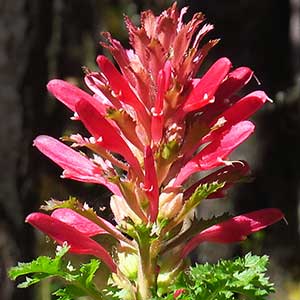Pedicularis densiflora
Pedicularis pennellii
Indian warrior, warrior's plume
Pennell's lousewort
basal 1–10, blade lanceolate, 30–200 x 20–70 mm, 2(or 3)-pinnatifid, margins of adjacent lobes nonoverlapping or extensively overlapping distally, 1-serrate, surfaces glabrous, hispid, or downy;
cauline 4–20, blade lanceolate, 15–250 x 5–100 mm, 2-pinnatifid, margins of adjacent lobes nonoverlapping or extensively overlapping distally, serrate, surfaces glabrous, hispid, or downy.
basal 0–2, blade elliptic, 1–10 x 1–5 mm, 1-pinnatifid, margins of adjacent lobes nonoverlapping or slightly overlapping distally, dentate, surfaces glabrous;
cauline 0–5, blade lanceolate or elliptic to deltate, 7–30 x 1–25 mm, 1- or 2-pinnatifid, margins of adjacent lobes nonoverlapping or slightly overlapping distally, serrate, surfaces glabrous.
simple, 1–5, exceeding basal leaves, each 10–50-flowered;
bracts lanceolate to trullate, 10–35 x 3–5 mm, undivided or 1-pinnatifid, proximal margins entire, distal 1- or 2-serrate, surfaces glabrous.
simple or paniculate, 1–3, exceeding basal leaves, each 8–20-flowered;
bracts deltate, 5–20 x 10–15 mm, 1- or 2-pinnatifid nearly to midrib, lobes sometimes laciniate, margins serrate, surfaces glabrous.
2–4 mm.
1–1.5 mm.
calyx 9–18 mm, downy to tomentose, lobes 5, triangular, 3–4 mm, apex entire, ciliate;
corolla 23–43 mm, tube dark red, purple, or orange-yellow, rarely white, 8–18 mm;
galea dark red, purple, or orange-yellow, rarely white, 15–25 mm, beakless, margins entire medially and distally, apex straight;
abaxial lip dark red, purple, or orange-yellow, rarely white, 8–15 mm.
calyx 3.5–8.5 mm, glabrous, lobes 2(–4), triangular, 2–6 mm, apex dentate to 2-dentate, glabrous;
corolla 8–16 mm, tube light pink to purple, 5–9 mm;
galea bicolored, yellow with purple spots proximally, purple distally, 3–6.5 mm, beakless, margins 1-toothed medially and distally, apex straight to arching slightly over abaxial lip;
abaxial lip yellow to pink with purple spots, 3–8 mm.
= 16.
= 16 (Asia).
Pedicularis densiflora
Pedicularis pennellii
Scarlet corollas with an undomed, toothless galea and two- or three-pinnatifid leaves are diagnostic of Pedicularis densiflora. This species occurs in forested subalpine regions of southern Oregon, western slopes of the Sierra Nevada, and the Coast Ranges of California south to Baja California. Herbarium records indicate northern populations of P. densiflora occur at higher elevations than do more southern populations.
(Discussion copyrighted by Flora of North America; reprinted with permission.)
Pedicularis palustris and P. pennellii are extensively branched, with branching in P. pennellii more compact and subequal, making it appear shrubby. The branches of P. palustris, in contrast, become progressively shorter distally on the stem, giving the plant a pyramidal appearance.
Calder and Taylor recognized subsp. insularis by its smaller or sometimes absent apical teeth on the galea margins. Boivin subsequently reduced it to a variety. Given this minor difference, this taxon (found only on Haida Gwaii [the Queen Charlotte Islands] of British Columbia) is not recognized here.
(Discussion copyrighted by Flora of North America; reprinted with permission.)


